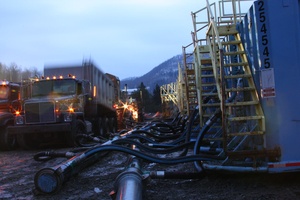
New Managing Director for Bellona Norway
The Board of the Bellona Foundation has appointed former Minister of Climate and the Environment Sveinung Rotevatn as Managing Director of Bellona No...
News

Publish date: December 20, 2012
Written by: Charles Digges
News
The $590 million deal expands the company’s assets in the Marcellus Shale gas deposits in the Appalachian region. Norway’s government owns 67 percent of Statoil’s shares.
Statoil’s newest foray into shale gas in the United States –which carries with it dangers to underground water deposits, releases of the potent greenhouse gas methane, natural uranium and seismic disturbances – has Bellona and its US environmental counterparts worried.
A relatively young technology, hydraulic fracturing, or “fracking,” to extract shale gas has been heavily criticized by Bellona and US environmental groups – particularly the Washington-based Natural Resources Defense Fund (NRDC) – and both groups say regulation of fracking has yet to catch up to the oil and gas bonanza it promises.
Hydraulic fracturing is a gas extraction process developed by Halliburton that pumps millions of gallons of water and ‘fracking fluids’ that contain mixtures of up to 250 toxic chemicals under high pressure to break apart the rock, forcing the gas to the surface.
In particular, the US is placing heavy bets on shale gas for its own energy independence and for export. Bellona advisor Karl Kristensen has said that the group has been critical of Statoils shale gas production in the past, and describes its commitement to expanding it in the US as “riskier.”
“I think it’s worrisome, both environmentally and commercially,” he told Norway’s NTB television, and said Statoil was taking needless risks when numerous environmental challenges need to be resolved before the shale gas revolution proceeds.
US Congresses’s independent watchdog, the Government Accountability Office (GAO) is also worried about what these risks may be, and compiled two reports released in Ocbober, finding, essential, that shale gas should not move forward in the US until codified regulation is in place.
The first is called “Oil and Gas: Information on Shale Resources, Development, and Environmental and Public Health Risks” (GAO-12-732) and the next “Unconventional Oil and Gas Development: Key Environmental and Public Health Requirements” (GAO-12-874).
Both constitute some 300 pages and each details shortcomings at shale gas and oil extraction sites discovered by the US Environmental Protection Agency (EPA).
Some for instances include violations of the US Clean Water Act, which requires some oil and gas production sites close to navigable waters and shorelines to have an oil spill prevention, control and cleanup plan. EPA officials visited 120 sites in 2011 and found 105 – or 87.5 percent – were out of compliance
Futher, reported the GAO, EPA officials do not always have information on the types of activities taking place or equipment being used at well sites – or even where the well sites are – making it difficult for their enforcement staff to know where and when to conduct inspections.
The GAO concluded that shale development includes risks that cannot be quantified, and the magnitude or likelihood of potential adverse effects cannot be determined due to several factors, including insufficient scientific study.
Statoil spokesman Baard Glad Pedersen told Norwegian media that his company bought much of its latest US acreage, equaling 280 square kilometers, from the unlisted companies Grenadier Energy Partners, Protege Energy and PetroEdge Energy.
Early estimates of the expected yield from Statoils new purchase is expected to be between 300 and 500 million barrels of oil equivalent, Norwegian media reported. Current equity production is approximately 5,000 barrels of oil equivalent per day.
Statoil entered the Marcellus in 2008 through a partnership with Chesapeake Energy.
Statoil also owns shale land in Texas and operates leases in North Dakota and Montana.
Torstein Hole, head of Statoil’s onshore operations in the United States, also said Statoil is poised to make further acquisitons in the United States.
“Statoil went in early for shale gas and has over time built up a diverse portfolio of some of the most attractive areas in the United States,” said Hole to the Norwegian newspaper Nationen. “We are already operating in the Bakken, and we are on track in preparations for operating licenses in the Eagle Ford next year, and with this newest transaction, Statoil will be the operator in Marcellus.”
Though the Obama Administration is treading carefully around the subject of shale gas, it clearly expects its revenues to bear out in Barack Obama’s second presidency. Obama’s oft-repeated promise on the campaign trail to exploit America’s domestic reserves of gas and oil were a clear reference to moving forward with shale gas, said Bellona advisor Kieth Whiriskey.

The Board of the Bellona Foundation has appointed former Minister of Climate and the Environment Sveinung Rotevatn as Managing Director of Bellona No...

Økokrim, Norway’s authority for investigating and prosecuting economic and environmental crime, has imposed a record fine on Equinor following a comp...

Our op-ed originally appeared in The Moscow Times. For more than three decades, Russia has been burdened with the remains of the Soviet ...

The United Nation’s COP30 global climate negotiations in Belém, Brazil ended this weekend with a watered-down resolution that failed to halt deforest...